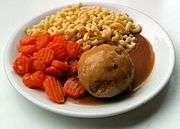Caul fat

Pig's caul fat
Caul fat, also known as lace fat, mesentery, crépine or fat netting, is the thin membrane which surrounds the stomach internal organs of some animals, such as cows, sheep, and pigs, also known as the greater omentum. It is used as a casing for sausages, roulades, pâtés, and various other meat dishes.[1] Examples of such dishes are Swiss atriau,[2] French crépinette,[3] Cypriot sheftalia, English faggots,[1] and Italian fegatelli. In the traditional Ukrainian and Russian cuisine, caul fat, known as salnik or salnyk, was usually filled with kasha and liver, and baked in a clay pot in the Russian oven.[4]
- Caul fat dishes
-

Salnyk
-
.jpg)
Ostrich crépinette
-
French veal sausage bundle (Feuilleton de veau)
-

Atriau served with pasta and carrots
References
- 1 2 "BBC - Food - Caul fat recipes". BBC. Retrieved 7 October 2012.
- ↑ Association Fribourgeoise des Paysannes (Eds.). Küche & Traditionen im Freiburgerland. Editions Fragnière, Fribourg (Switzerland) 1996, p. 133 (in German)
- ↑ Crépinette. Food Dictionary at Epicurious.com.
- ↑ Вильям Похлебкин. Большая энциклопедия кулинарного искусства, Сальник. Москва: Центрполиграф, 2010, ISBN 978-5-9524-4620-5 (William Pokhlyobkin. The Great Encyclopedia of Culinary Art, "Salnik". Moscow: Centrpoligraph, 2010; in Russian)
This article is issued from Wikipedia - version of the 9/20/2016. The text is available under the Creative Commons Attribution/Share Alike but additional terms may apply for the media files.